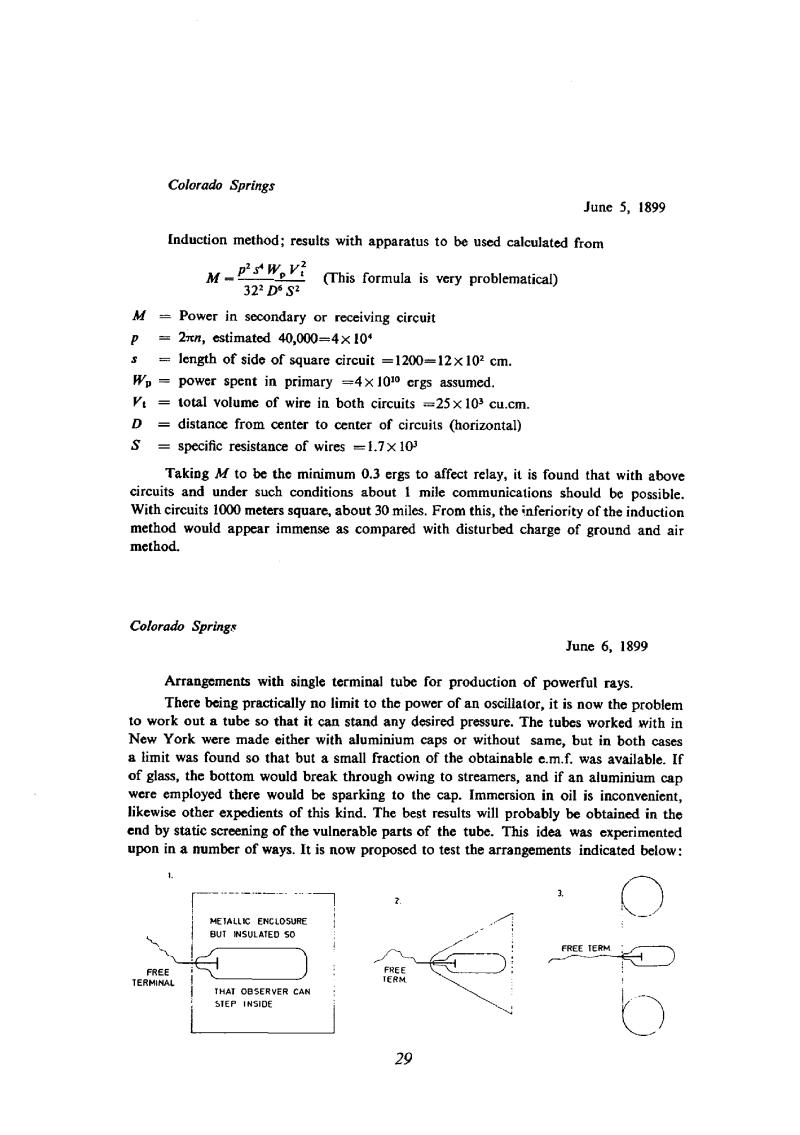
Nikola Tesla Books
Colorado Springs
June 5, 1899
Induction method; results with apparatus to be used calculated from
M = $! {p^{2} s^{4} W p V^{2} t \over 32^{2} D^{6} S^{2}} $! (This formula is very problematical)
M = Power in secondary or receiving circuit
p = 2â¼n, estimated 40,000=4x104
s = length of side of square circuit =1200=12x102 cm.
Wp = power spent in primary =4x1010 ergs assumed.
Vt = total volume of wire in both circuits =25x103 cu.cm.
D = distance from center to center of circuits (horizontal)
S = specific resistance of wires =1.7x103
Taking M to be the minimum 0.3 ergs to affect relay, it is found that with above circuits and under such conditions about 1 mile communications should be possible. With circuits 1000 meters square, about 30 miles. From this, the inferiority of the induction method would appear immense as compared with disturbed charge of ground and air method.
Colorado Springs
June 6, 1899
Arrangements with single terminal tube for production of powerful rays.
There being practically no limit to the power of an oscillator, it is now the problem to work out a tube so that it can stand any desired pressure. The tubes worked with in New York were made either with aluminium caps or without same, but in both cases a limit was found so that but a small fraction of the obtainable e.m.f. was available. If of glass, the bottom would break through owing to streamers, and if an aluminium cap were employed there would be sparking to the cap. Immersion in oil is inconvenient, likewise other expedients of this kind. The best results will probably be obtained in the end by static screening of the vulnerable parts of the tube. This idea was experimented upon in a number of ways. It is now proposed to test the arrangements indicated below:
29
June 5
Tesla does not state the origin of the formula he uses to calculate M, the power induced in the secondary, receiving coil, by the primary fed with a power of 4 kW (or 4 x 1010 erg/sec, not ergs). Although he himself expresses doubts about the calculation, the conclusion he draws is correct, i.e. that these mode of transmission is greatly inferior to that which he calls the method of âdisturbed charge of ground and airâ, in fact that of electromagnetic radiation.
June 5
Tesla mentions the source of the equation he uses to calculate the power received by the receiving coil via induction from the primary coil which is supplied by 4kW (or 4 x 1010 erg/sec, but not erg) power. Although he has some doubts regarding the correctness in this procedure, Tesla develops the conclusion that this transmission method is considerably inferior to the method he titles the "Ground and Air Loading Disturbance method".
June 6
June 6
During the work on darkened Crookes tubes Rontgen observed on Nov. 8, 1895, the glimmering of barium platinum-cyanide crystals and discovered it was the consequence of unknown rays to which he gave the name X-Rays. At the end of the same year Rontgen gave a lecture about his discovery and in an unbelievably short time the entire world was informed about Rontgen's works(66).
During this time Tesla intensively studied the X-rays and his study results he published in ten articles between March 11, 1896, and Aug. 11, 1897(7). On Apr. 6, 1897, he gave a lecture on his works related to Rontgen rays(17) and showed a number of pieces of equipment for the device for the purpose of powerful X-ray production. In that lecture Tesla gave the interesting data on his previous studies of the operation of Crooke's tube in 1894. He observed then that some tubes which produced poorly visible light, influenced the sensitized photographic plate more powerfully than other tubes which produced visible light of higher level.
Tesla's studies were directed towards achievement of real phosphorescent light ("cool light") so that he delayed for some time, detailed examination of the mentioned event, as well as the cause of the appearance of various spots and the blurred photographic plates which were in the laboratory for a certain period of time after use. When he started to work on these problems, a fire occurred in the laboratory in which almost all the devices were destroyed (Mar. 13, 1895). Several months passed before he continued working on his studies and in the meantime, Rontgen published his discoveries. When Tesla found that, it was immediately clear to him what occured in his laboratory. Tesla repeated Rontgen's experiments, which were very briefly described, and he realized that he had made a mistake by not following certain observations he made during his studies with Crookes tubes.
During 1897-1898 Tesla performed many experiments with Rontgen rays. He was thinking about the nature of these rays and considered that they were caused by "particles or vibrations which are considerably above any frequency we are able to produce by capacitor discharge". He immediately observed the importance of high-voltage for the purpose of powerful ray production and suggested the application of his tubes with one electrode connected to the arcing oscillator secondary. It is interesting that Rontgen in the same month that Tesla published his first article, pointed to the great advantage in using Tesla's high frequency oscillator for X-ray production during a lecture to the Wurzburg Medical Society. Tesla performed X-ray refraction and transmission measurements on several metals, lead-glass, liscone and ebony. It is not certain however that he actually measured the refracted rays' intensity or that it was a question of secondary ray emission. Tesla attempted to prove the phenomenon of refraction, but he was not successful due to now understandable reasons. In his works and in his lecture at the American Science Academy, Tesla showed a series of tube designs for the production of power X-rays, most of which are similar to Leonard tubes (which Tesla frequently mentions), but without anode terminal.


